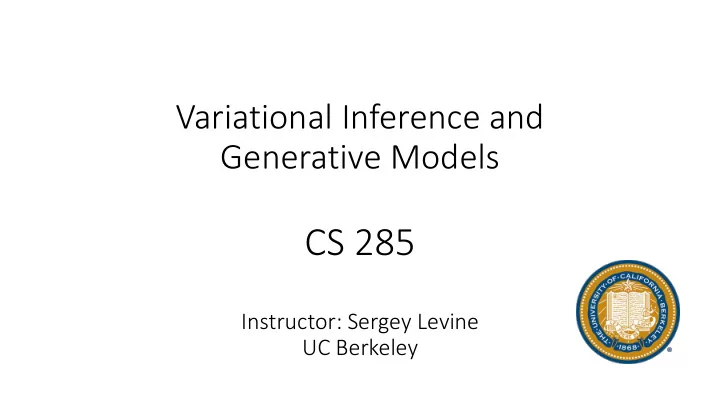

Variational Inference and Generative Models CS 285 Instructor: Sergey Levine UC Berkeley
Today’s Lecture 1. Probabilistic latent variable models 2. Variational inference 3. Amortized variational inference 4. Generative models: variational autoencoders • Goals • Understand latent variable models in deep learning • Understand how to use (amortized) variational inference
Probabilistic models
Latent variable models mixture element
Latent variable models in general “easy” distribution “easy” distribution (e.g., conditional Gaussian) (e.g., Gaussian) “easy” distribution (e.g., Gaussian)
Latent variable models in RL conditional latent variable latent variable models for models for multi-modal policies model-based RL
Other places we’ll see latent variable models Using RL/control + variational inference to model human behavior Muybridge (c. 1870) Mombaur et al. ‘09 Li & Todorov ‘06 Ziebart ‘08 Using generative models and variational inference for exploration
How do we train latent variable models?
Estimating the log-likelihood
Variational Inference
The variational approximation
The variational approximation Jensen’s inequality
A brief aside… Entropy: high Intuition 1: how random is the random variable? Intuition 2: how large is the log probability in expectation under itself low this maximizes the first part this also maximizes the second part (makes it as wide as possible)
A brief aside… KL-Divergence: Intuition 1: how different are two distributions? Intuition 2: how small is the expected log probability of one distribution under another, minus entropy? why entropy? this maximizes the first part this also maximizes the second part (makes it as wide as possible)
The variational approximation
The variational approximation
How do we use this? how?
What’s the problem?
Amortized Variational Inference
What’s the problem?
Amortized variational inference how do we calculate this?
Amortized variational inference look up formula for entropy of a Gaussian can just use policy gradient! What’s wrong with this gradient?
The reparameterization trick Is there a better way? most autodiff software (e.g., TensorFlow) will compute this for you!
Another way to look at it… this often has a convenient analytical form (e.g., KL-divergence for Gaussians)
Reparameterization trick vs. policy gradient • Policy gradient • Can handle both discrete and continuous latent variables • High variance, requires multiple samples & small learning rates • Reparameterization trick • Only continuous latent variables • Very simple to implement • Low variance
Example Models
The variational autoencoder
Using the variational autoencoder
Conditional models
Examples
1. collect data 2. learn embedding of image & dynamics model ( jointly ) 3. run iLQG to learn to reach image of goal a type of variational autoencoder with temporally decomposed latent state!
Local models with images
Local models with images variational autoencoder with stochastic dynamics
We’ll see more of this for… Using RL/control + variational inference to model human behavior Muybridge (c. 1870) Mombaur et al. ‘09 Li & Todorov ‘06 Ziebart ‘08 Using generative models and variational inference for exploration
Recommend
More recommend